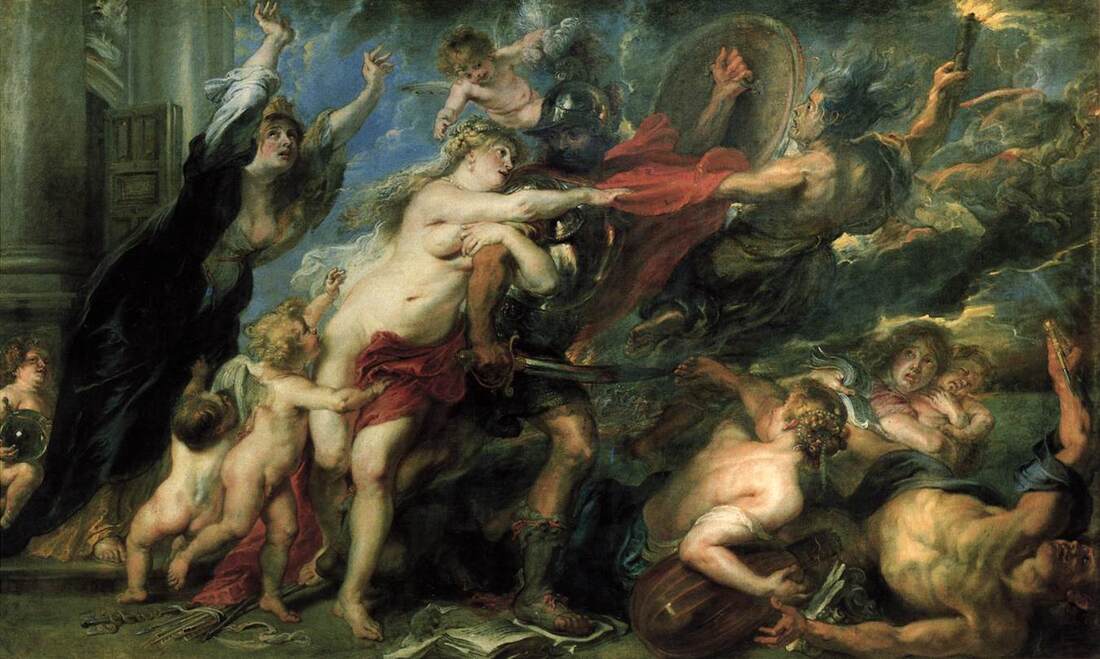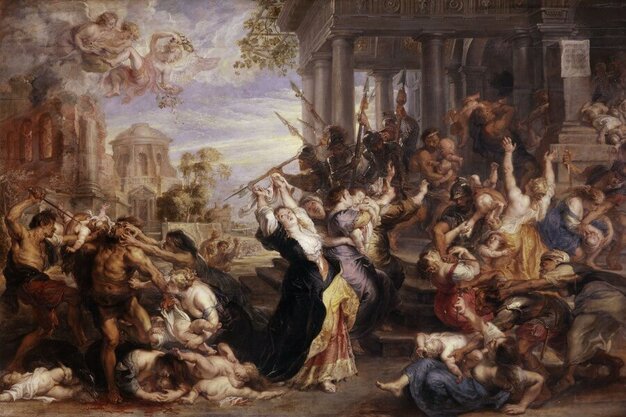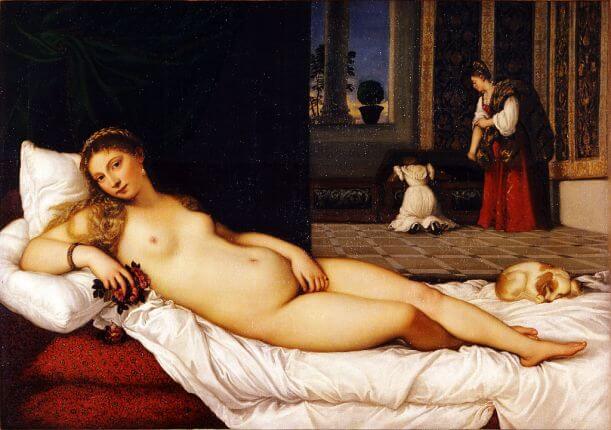|
Where? Room 26 in the Palatine Gallery in the Palazzo Pitti
When? 1638-1639 Commissioned by? Ferdinando II de’ Medici, the Grand Duke of Tuscany What do you see? In the middle of the painting, you see Mars (the god of war) with his armor, helmet, red cape, shield, and bloody sword. Mars is stepping on top of a book and a drawing. To the left of him, you can see Venus (the goddess of love) who clings to his arm. She tries to seduce him and to pull him back from the war. Venus is largely naked and has a red cloth between her legs. To her left and above her are two small Cupids with wings who try to help her. Below the standing Cupid, you can see some arrows, a caduceus, and an olive branch laying on the ground. To the right of Mars is Alecto, one of the Erinyes whose job it is to punish the moral crimes of humans. Alecto has a torch in one hand and is pulling the left arm of Mars to engage him in the war. To her right are two evil-looking figures that add to the aggressiveness of war in this painting. Below Alecto is the goddess Harmony holding a broken mandolin while being pushed to the ground. To her right is an architect laying on the ground holding a compass and some of his other tools have fallen. Above them are a mother and a child. On the left, you can see a despaired woman dressed in black with her arms up in the air. This woman represents Europe and you can also see her in the middle of Rubens’s earlier painting Massacre of the Innocents in the Alte Pinakothek in Munich. To the left of this woman is an angel holding a globe with a small cross on top of it. Above this angel is the Temple of Janus which is on the Roman Forum in Rome.
Backstory: Rubens received a commission for a painting for the Grand Duke of Tuscany through an intermediary in Florence called Justus Sustermans. Rubens was allowed to pick his own topic, and following his desire for peace, he proposed to create a painting on the consequences of war. He created a couple of sketches on his ideas for the painting which the Duke approved.
Rubens painted the work while he was in his studio in Antwerp. This painting is sometimes also referred to as the Horror(s) of War. The painting reflects Rubens’ views on how the Thirty Years’ War between 1618 and 1648 affected Europe. Symbolism: Venus, the goddess of love, tries to persuade Mars, the god of war, to end the violent war, but Mars is not listening. So, this painting symbolizes the victory of warfare over peace. The gloomy woman dressed in black, who is not wearing any jewelry, represents Europe, which has suffered from war, abuse, and looting during the Thirty Years’ War. The door of the Temple of Janus is open, which was only the case during wartime as the door was closed when there was peace. The globe with the cross on top of it represents the Christian world. The arrows, caduceus, and olive branch represent the absence of peace. In addition, there are also several symbols present to indicate the consequences of war. Specifically, war has bad consequences for life (indicated by the woman holding the baby), culture (indicated by Mars stepping on a book and a drawing), arts (indicated by Harmony being pushed to the ground while holding the broken mandolin), and crafts and architecture (indicated by the man on the right holding a compass. What is the Thirty Years’ War? This very complex war took place between 1618 and 1648 and involved the area which is currently Germany. Many different countries were involved at different stages of the war, including Austria, Denmark, England, France, Spain, and Sweden. There were a total of eight million casualties in this war. This war started as one between Catholic and Protestant areas in Europe but developed later into a war between some of the most powerful European countries. Who is Rubens? Peter Paul Rubens (1577-1640) was born near Cologne in Germany where his family was exiled. When Rubens was ten years old, his family returned to Antwerp where they were originally from. Antwerp was one of the bigger cities in Europe at that time. Rubens received a good education and traveled throughout Europe to learn about art. He spent several years in Italy and was impressed by the art that he saw in Florence, Rome, and Venice. He got inspired by artists such as Caravaggio, Michelangelo, Raphael, and Titian. For example, the Venus in this painting shows quite some similarities to the Venus as painted by Titian in the Venus of Urbino which is in the Uffizi Museum. At age 29, Rubens returned to Antwerp where he built a large Italian-style house which served as his house and his art studio. The house has survived and is now called the Rubenshuis and serves as a museum about Rubens.
Fun fact: Throughout his life, Rubens traveled all across Europe to complete different commissions. He was the court painter for several kings and queens. Rubens did not like war and was passionate about creating peace. So, during his trips through Europe and while visiting the leaders of several countries, he started to act as a peace negotiator between the different countries involved in war.
As an example, Rubens was very active as a diplomate between 1627 and 1630 trying to bring peace between England and Spain. However, he always combined his diplomatic trips with studying art in the different countries as he was first and foremost an artist.
Written by Eelco Kappe
References:
1 Comment
|
Categories
All
|
- Home
- Blog
-
Museums
- Alte Pinakothek
- Art Institute of Chicago
- Baltimore Museum of Art
- Barber Institute of Fine Arts
- Bargello
- Barnes Foundation
- British Museum
- Church of Sant’Anastasia
- Cleveland Museum of Art
- Courtauld Institute of Art
- Detroit Institute of Arts
- Frans Hals Museum
- Galleria Borghese
- Gallerie dell'Accademia
- Getty Museum
- Guggenheim
- Hermitage Museum
- Kunsthistorisches Museum
- Kunstmuseum Basel
- Legion of Honor Museum
- Louvre
- Mauritshuis
- Metropolitan Museum of Art
- Musee d’Orsay
- Museum of Fine Arts in Boston
- Museum of Modern Art
- National Gallery in London
- National Gallery of Art
- National Museum in Poznań
- Norton Simon Museum
- Ny Carlsberg Glyptotek
- Palace of Versailles
- Palazzo Pitti
- Palazzo Vecchio
- Petit Palais
- Philadelphia Museum of Art
- Prado
- Pushkin Museum
- Ravenna Art Museum
- Rijksmuseum
- San Diego Museum of Art
- Santa Maria delle Grazie
- St. Peter's Basilica
- Städel Museum
- Statens Museum for Kunst
- Tate Britain
- Tate Modern
- Timken Museum of Art
- Uffizi
- Vatican Museums
- Wallace Collection
-
Artists
- Altdorfer
- Anguissola
- Berlin Painter
- Bosch
- Botticelli
- Boucher
- Bronzino
- Bruegel the Elder
- Brunelleschi
- Cabanel
- Caillebotte
- Canova
- Caravaggio
- Carpeaux
- Cezanne
- Cimabue
- David
- Degas
- Delacroix
- De Maria
- Donatello
- El Greco
- Fontana
- Fra Angelico
- Fragonard
- Gauguin
- Gentileschi
- Gericault
- Gonzalez-Torres
- Goya
- Hals
- Hogarth
- Hokusai
- Ingres
- Leonardo da Vinci
- Lippi, Filippo
- Longhi, Barbara
- Lorrain
- Makovsky
- Manet
- Massys
- Matisse
- Merian
- Michelangelo
- Mochi
- Modigliani
- Monet
- Panini
- Parmigianino
- Perugino
- Picasso
- Pisanello
- Raphael
- Rembrandt
- Renoir
- Reynolds
- Rivera
- Rodin
- Rubens
- Scultori
- Seurat
- Steen
- Tintoretto
- Titian
- Toulouse-Lautrec
- Turner
- Uccello
- Van der Weyden
- Van Dyck
- Van Eyck
- Van Gogh
- Van Hemessen
- Vasari
- Velazquez
- Vermeer
- Veronese
- Vigée Le Brun
-
Locations
- Books
- About Us



